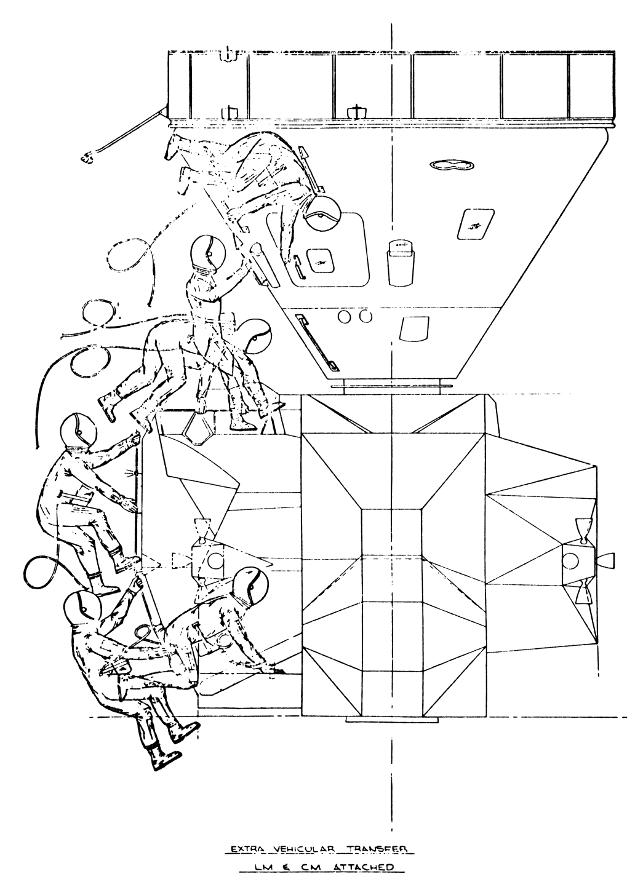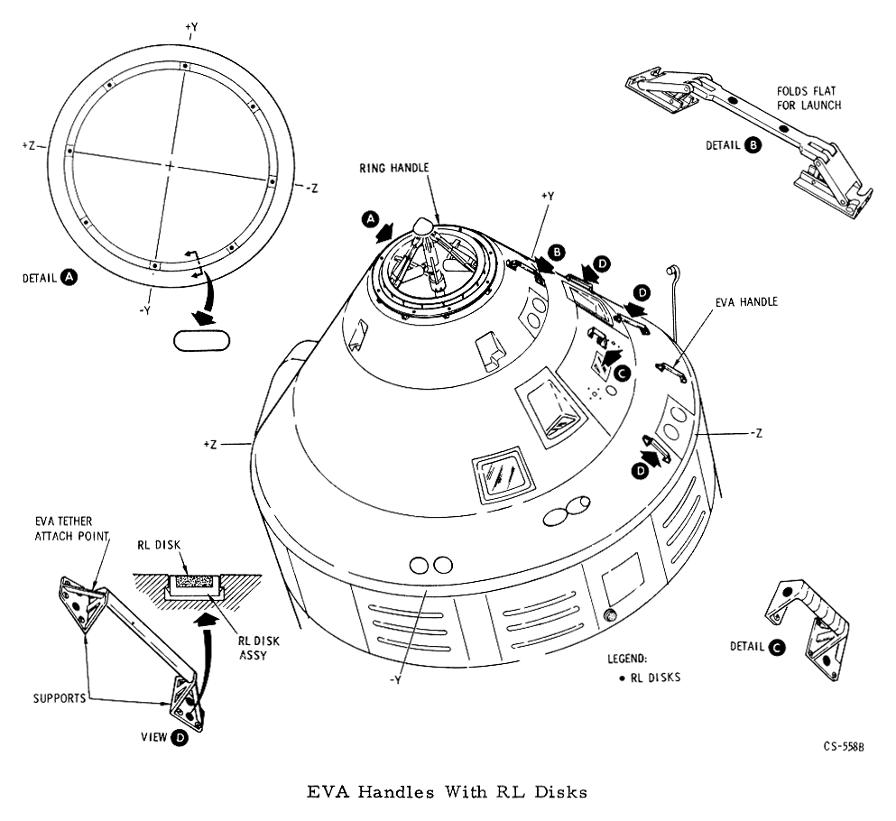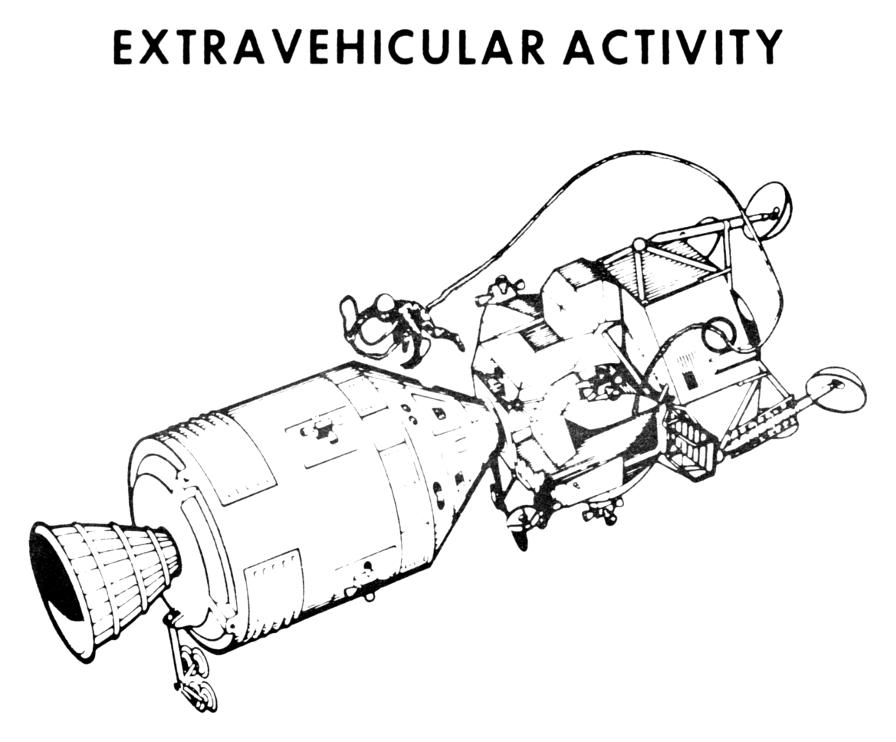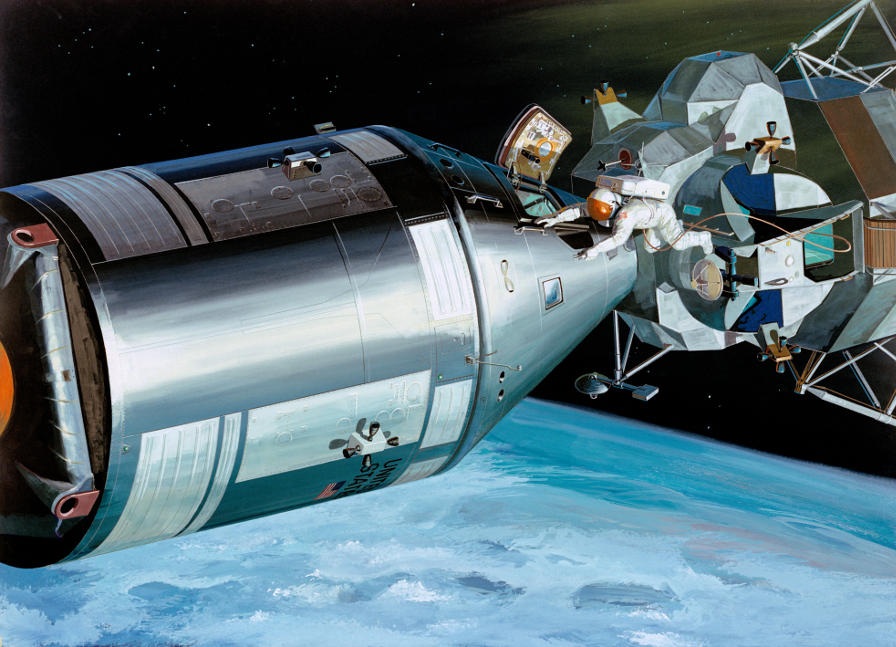LM to CM Extravehicular Transfer
After the lunar module and command/service module docked in lunar orbit, crew transfer would ordinarily involve the command module pilot removing the CM's probe assembly and docking hatch, while the LM crew would open the LM's docking hatch and remove the drogue.
In the event that some problem prevented the successful execution of this procedure, the LM crew would transfer to the CM via an EVA: They would exit the lunar module via the ingress/egress hatch and use the EVA handrail to move "up" the lunar module to the command module, where they would then use the CM's EVA handles to move to the command module's hatch.
During the extravehicular transfer, the astronauts would don the oxygen purge system (OPS), retained from their lunar surface portable life support system (PLSS), and wear it around their waist.
Unlike the image below, the command module pilot would presumably have opened the side hatch ...
Click image for a 4154x5827 pixel version of this image in a new window.
From p. 20b of the Apollo 9 Press Kit, located in the Apollo 14
Collection and Misc. Material, Dept. of Archives/Special
Collections, M. Louis Salmon Library, University of Alabama in
Huntsville. Also available in electronic format from the Apollo
9 Press Kit [direct link to 4.8 meg PDF] from the heroicrelics
mirror of the Kennedy Space Center Library press kit page; refer to page 38
of that PDF.
Scan, cleanup, and adaptation by heroicrelics.
The command module's EVA handles included a ring handle on the command module docking tunnel, an extendible handle on the forward heat shield, four fixed handles on the side of the command module, and a handle on the side hatch.
Navigating along the command module was facilitated by a number of radioluminescent (RL) disks. These disks, infused with promethium 147, were slightly radioactive, glowed in the dark, and provided illumination for the astronauts. The disks were approximately 5/8 inch in diameter.
These RL disks were located on each of the EVA handles to assist in location:
- The ring handle was a tube connected to the docking ring by eight supports; each support had an RL disk on the forward side. The ring handle is visible in the full-resolution versions, for example, of AS17-145-22273 and AS17-145-22254.
- The pop-up handle on the forward heat shield had two RL disks on the face of the handle.
- The four handles on the CM exterior had two RL disks on each of the handle support fittings bolted to the CM.
- The handle on the hatch had two RL disks on the aft handle fitting and one on the forward face of the handle.
Click image for a 993x910 pixel version of this image in a new window.
Adapted from page 2-12-52 of the Apollo Operations
Handbook, Block II Spacecraft, Volume 1: Spacecraft Description;
refer to page 55 of the "Crew Personal Equipment" PDF.
Extraction and adaptation by heroicrelics.org.
This method of transfer from the lunar module to the command module was never required during an Apollo mission, although a test of this procedure was planned for the Apollo 9 mission: Lunar Module Pilot Rusty Schweickart would have donned his full extravehicular mobility unit and, performing the first and only test of the portable life support system (PLSS) before the impending moon landing, would have transferred from the LM to the CM, partially entered the CM, and then transferred back to the lunar module for additional experiments.
This EVA would have differed from the emergency extravehicular transfer in that the in Apollo 9 exercise Schweickart would have worn a full PLSS; during a lunar mission the PLSSes would have been jettisoned on the lunar surface prior to ascent in order to save weight, but the OPS would be retained in case of an emergency EV transfer. As noted above, the astronauts would have the OPS at the waist during the transfer.
Also, the Apollo 9 Press Kit notes that the LMP would be "tethered by a nylon rope" during the transfer. It is unclear from the description whether Schweickart would be permanently tethered to the lunar module or whether he would have used a tether that moved with him. The fixed EVA handles had a small bar on each handle support to which a tether could be attached, and the handle on the hatch had a single tether attach point. During an emergency EV tranfer, the astronaut would attach tethers to the handles and move the tethers along with him as he made his way to the command module hatch.
The reason for my doubt regarding the tether is is that the diagram below (from the Apollo 9 Press Kit) is somewhat fanciful: The astronaut is depicted floating in space (rather than holding any of the CM EVA handrails) and has no PLSS (or even an OPS). The command module hatch is not open, as it would have been during the Apollo 9 EVA. There are no handrails depicted at all in the diagram, and of course the handrails are on the same side of the CM as the LM's hatch, so the astronaut would not be on that side of the CM (in fact, if the astronaut were where he's depicted below, he would be hit by the hatch, which is hinged on that side).
Click image for a 4675x3873 pixel version of this image in a new window.
From p. 20a of the Apollo 9 Press Kit, located in the Apollo 14
Collection and Misc. Material, Dept. of Archives/Special
Collections, M. Louis Salmon Library, University of Alabama in
Huntsville. Also available in electronic format from the Apollo
9 Press Kit [direct link to 4.8 meg PDF] from the heroicrelics
mirror of the Kennedy Space Center Library press kit page; refer to page 37
of that PDF.
Scan and cleanup by heroicrelics.
The following painting is a much more accurate depiction of the Apollo spacecraft and the planned EVA. The astronaut is using a PLSS (and its hoses even disappear below a suit connector cover assembly, even though the cover was phased out before the mission actually flew). In this image, Schweickart does not use a movable tether, but rather has a tether leading back into the lunar module.
There are a number of impressive details in the painting, including the movie camera affixed to the command module hatch and the docking spotlight on the service module. The handrail on the LM is wrong, but the painting's description on the NASA site below indicates that the it was painted by a North American Aviation artist, so one might not expect them to be familiar with the finer details of the lunar module.
NASA image S69-18547.
Click image to open additional information on this photo in a new window.
This EVA ultimately never took place, as Schweickart suffered a bout of space adaptation syndrome (space sickness) and performed an abridged EVA which never ventured far from the lunar module's hatch.




